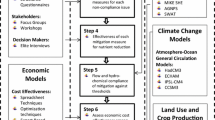Abstract
Most public decisions ultimately have economic content. Decisions that deal with externalities, such as pollution, carry costs as well as benefits for society. Actions that mitigate nutrient over-enrichment in the Gulf of Mexico would require actions throughout the Mississippi River Basin resulting in both direct and indirect economic impacts. This paper describes and explains the economic linkages and trade-offs involved in actions that could be cost effective and meet a public goal of reducing nitrogen over-enrichment within the Mississippi River Basin. The impacts of different approaches that reduce the major source of nitrogen flows to the Gulf, nonpoint pollution from agriculture, are simulated for both source reduction the major source of nitrogen flows to the Gulf, nonpoint pollution from agriculture, are simulated for both source reduction and interception of nitrogen. Lessons learned include the fact that any one approach by itself has increasing marginal cost. The approaches considered have modest direct and indirect costs when only required to mitigate 20% to 25% of the nitrogen losses. Simultaneous multiple approaches appear even more attractive to induce only moderate negative impact. The impacts of mitigation are not just confined to the Mississippi River Basin but spread beyond the basin and are themselves influenced by external factors such as commodity prices and import and export markets for agricultural commodities. Success in reducing excess nitrogen flows will depend on institutional factors as well as technical efficacy. Finally, the nature of soil system sinks and the resulting long lead time likely before results might be apparent present a special obstacle to enlisting cooperation, assessing efficacy, and designing adaptive behavior.
Similar content being viewed by others
Literature Cited
Brezonik, P., V. Bierman, Jr.,R. Alexander, J. Anderson, J. Barko, M. Dortch, L. Hatch, G. Hitchcock, D. Keeney, D. Mulla, V. Smith, C. Walker, T. Whitledge, andW. Wiseman, Jr. 1999. Effects of reducing nutrient loads to surface waters within the Mississippi River basin and the Gulf of Mexico. Topic 4 Report for the Integrated Assessment on Hypoxia in the Gulf of Mexico. NOAA Coastal Ocean Program Decision Analysis Series No. 18. National Oceanic and Atmospheric Administration, Silver Spring, Maryland.
Carpenter, S., N. Caraco, D. Correll, R. Howarth, A. Sharpley, andV. Smith. 1998. Nonpoint pollution of surface waters with phosphorus and nitrogen.Issues in Ecology 3:1–3.
Diaz, R. andA. Solow 1999. Ecological and economic consequences of hypoxia. Topic 2 Report for the Integrated Assessment on Hypoxia in the Gulf of Mexico. NOAA Coastal Ocean Program Decision Analysis Series No. 16. National Oceanic and Atmospheric Administration, Silver Spring, Maryland.
Doering, O., F. Diaz-Hermelo, C. Howard, R. Heimlich, F. Hitzhusen, R. Kazmierczak, J. Lee, L. Libby, W. Millon, T. Prato, andM. Ribaudo. 1999. Evaluation of the economic costs and benefits of methods for reducing nutrient loads to the Gulf of Mexico. Topic 6 Report for the Integrated Assessment on Hypoxia in the Gulf of Mexico. NOAA Coastal Ocean Program Decision Analysis Series No. 20. National Oceanic and Atmospheric Administration. Silver Spring, Maryland.
Downing, J. A., N. N. Rabalais, R. Diaz, R. Zimmerman, J. L. Baker, and M. D. Duffy. 1999. Gulf of Mexico Hypoxia: Land-Sea Interactions. Council for Agricultural Science and Technology, Task Force Report No. 134. Ames, Iowa.
Goolsby, D., W. Battaglin, G. Lawrence, R. Artz, B. Aulenbach, R. Hooper, D. Keeney, andG. Stensland. 1999. Flux and sources of nutrients in the Mississippi-Atchafalaya River basin. NOAA Coastal Ocean Program. Topic 3 Report for the Integrated Assessment on Hypoxia in the Gulf of Mexico. NOAA Coastal Ocean Program Decision Analysis Series No. 17. National Oceanic and Atmospheric Administration, Silver Spring, Maryland.
Heimlich, R., K. Wiebe, R. Claassen, D. Gadsby, andR. House. 1998. Wetlands and agriculture: Private interests and public benefits. Agricultural Economics Report 765. Economic Research Service, U.S. Department of Agriculture, Washington, D.C.
House, R., M. Peters, andH. McDowell 1999. USMP Regional Agricultural Model. Unpublished Technical Document. Economic Research Service, U.S. Department of Agriculture, Washington, D.C.
Huang, W. andM. LeBlanc. 1994. Market-based incentives for addressing non-point water quality problems: A residual nitrogen tax approach.Review of Agricultural Economics 16:427–440.
Mitsch, W., J. Day Jr.,J. Gilliam, P. Groffman, D. Hey, G. Randall, andN. Wang. 1999. Reducing nutrient loads, especially nitrate-nitrogen, to surface water, ground water, and the Gulf of Mexico. Topic 5 Report for the Integrated Assessment on Hypoxia in the Gulf of Mexico. NOAA Coastal Ocean Program Decision Analysis Series No. 19. National Oceanic and Atmospheric Administration, Silver Spring, Maryland.
Rabalais, N., R. Turner, D. Justić, Q. Dortch, andW. Wiseman Jr. 1999. Characterization of hypoxia. Topic 1 Report for the Integrated Assessment on Hypoxia in the Gulf of Mexico. NOAA Coastal Ocean Program Decision Analysis Series No. 15. National Oceanic and Atmospheric Administration, Silver Spring, Maryland.
Ribaudo, M., R. Heimlich, R. Claassen, andM. Peters. 2001. Least-cost management of nonpoint source pollution: Source reduction vs. interception strategies for controlling nitrogen loss in the Mississippi Basin.Ecological Economics 37:183–197.
Smith, R., G. Schwartz, andR. Alexander. 1997. Regional interpretation of water-quality monitoring data.Water Resources Research 35:2781–2798.
Soil Conservation Service. 1994. Summary Report, 1992 Natural Resources Inventory. Soil Conservation Service, U.S. Department of Agriculture, Washington, D.C.
Vitousek, P., J. Aber, R. Howarth, G. Likens, P. Matson, D. Schindler, W. Schlesinger, andG. Tilman. 1997. Human alteration of the global nitrogen cycle: Causes and consequences.Issues in Ecology 1:1–16.
World Agricultural Outlook Board (WAOB). 1997. Agricultural baseline projection to 2005. Reflecting the 1996 Farm Act. Staff Report WAOB-97-1 U.S. Department of Agriculture. Office of the Chief Economist, Washington, D.C.
Williams, J., C. Jones, andP. Dyke. 1990. The EPIC model: EPIC—Erosion/Productivity Impact Calculator, model documentation, p. 3–92.In A. Sharpley and J. Williams (eds.), EPIC—Erosion/Productivity Impact Calculator 1, Model Documentation. U.S. Department of Agriculture Technical Bulletin No. 1768. U.S. Department of Agriculture, Washington, D.C.
Author information
Authors and Affiliations
Corresponding author
Rights and permissions
About this article
Cite this article
Doering, O.C. Economic linkages driving the potential response to nitrogen over-enrichment. Estuaries 25, 809–818 (2002). https://doi.org/10.1007/BF02804907
Received:
Accepted:
Issue Date:
DOI: https://doi.org/10.1007/BF02804907




